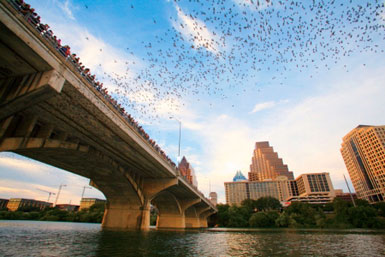If you read our daily news, you know we’re about green business, but we see it as a way to care for the earth and all its species.
With that in mind, the National Wildlife Federation (NWF) is honoring 10 cities where people are showing a strong commitment to wildlife. Rankings is based on the percentage of open space; citizen action to create wildlife habitat, and wildlife gardens at schools.
1. The entire city of Austin, Texas is certified as a Community Wildlife Habitat. There are 2,154 certified wildlife habitats – the most per capita in the US – and the most Schoolyard Habitats (67). It’s famous for its Congress Avenue Bridge, home to 1.5 million bats. More than 100,000 people visit the bridge each year to watch the bats emerge at dusk.

2. People that live in Portland, Oregon have the delight of seeing Chinook salmon swim through the heart of the city, where Oregon’s two largest spring runs converge, thanks to decades of restoration work. The city is also committed to providing access to natural areas within a half-mile of every citizen.
3. Atlanta, Georgia ranks high across the board, and NWF highlights the success of the Greater Atlanta Pollinator Partnership, started in 2009. The program creates pollinator habitat at landscape scale – around 1.2 million acres in the 25-mile radius around the city. It includes all major metropolitan parks and thousands of individual residences. It includes restoring native plants, rescuing them from construction sites, and controlling invasive species.
4. Baltimore, Maryland has 5700 acres of parkland, including the second-largest urban wilderness in the US, Gwynns Falls/Leakin Park. NWF and the National Aquarium are creating the largest certified Community Wildlife Habitat along the Chesapeake Bay. Certified community rain gardens are filtering runoff, preventing pesticides, fertilizers and other pollutants from entering Chesapeake Bay.
5. Washington DC is ranked third for parkland as a percent of city area, and bald eagles and osprey are returning to Anacostia River, once among the most polluted rivers in the US. Trash has been removed, invasive species are being controlled, and native wetland plants have been installed, and the river is rebounding.
6. More than 30 municipalities and neighborhoods in the Seattle, Washington area participate in NWF’s NWF’s Community Wildlife Habitat program. A "Green Factor" program reduces stormwater runoff and supports the use of native plants and trees.
7. Albuquerque, New Mexico has more parkland than another other city as a percent of its total area, home to sandhill cranes, Cooper’s hawks, black bears, bobcats and many other species.
8. Indianapolis, Indiana is located on the Mississippi Flyway and ranks second for certified wildlife habitats (932), in this case for migrating birds.
9. Charlotte, North Carolina ranks third for Certified Wildlife Habitats (849) and the city just achieved certification. The City Council’s goal is to have half the city covered by trees by 2050. The barred owl population is so strong that the most research study on the species is being done there.
10. New York City has the most Eco-Schools in America (270), ranks fourth in parkland as a percent of city area (14%), and is home to an incredible 168 species of wildlife and more than five million trees. Home to year-round residents like red-tailed hawks and migrating birds like black-throated blue warblers, it is a surprising urban wildlife haven that extends from Central Park to Brooklyn’s Gateway National Recreation Area.
Over several decades, Americans have preserved critical habitats and waterways and have brought bald eagles, grizzly bears, bison, wolves and other species back from the brink of extinction. Bison are returning to western and tribal lands for the first time in a century, says NWF.
Many of those species are under renewed attacks (by you know who), and now some of our most familiar species, from monarch butterflies and bees to frogs and bats, are in trouble.
Learn about NWF’s Certified Wildlife Habitat, Schoolyard Habitat and Eco-Schools USA programs – there are 200,000 certified habitats in the US and 84 certified Community Wildlife Habitats with another 50 in the pipeline.
